IN MY PREVIOUS POSTS, I discussed how fatigued I am with the bloated rules for 9e Warhammer 40K, and how I’ve ditched the game in favor of Grimdark Future, the streamlined, easier-to-play alternative by online upstart OnePageRules.

In tabletop wargames such as 40K and GDF, operational rules—how to set up and run the game (movement, combat resolution, etc.)—are only part of determining the quality of the game. Another big part is the armies that players can use.
Simplicity is the modus operandi of GDF, and that continues with its approach to selecting and building armies. Let’s look at how GDF does armies, compared with 40K.
Old Favorites With New Names
Grimdark Future is meant to be played with miniatures you already have (and some you might not), so no matter your 40K army, you’ll find it represented in GDF. To avoid infringing on Games Workshop’s intellectual property, OnePageRules uses generic names such as:
- Alien Hives for Tyranids;
- Battle Brothers for Adeptus Astartes;
- Dark Elf Raiders for Drukhari;
- Havoc Brothers for Chaos Space Marines;
- Human Defense Force for Astra Militarum;
- Orc Marauders for…well, you know;
- Robot Legions for Necrons; and,
- Wormhole Daemons for Chaos Daemons.
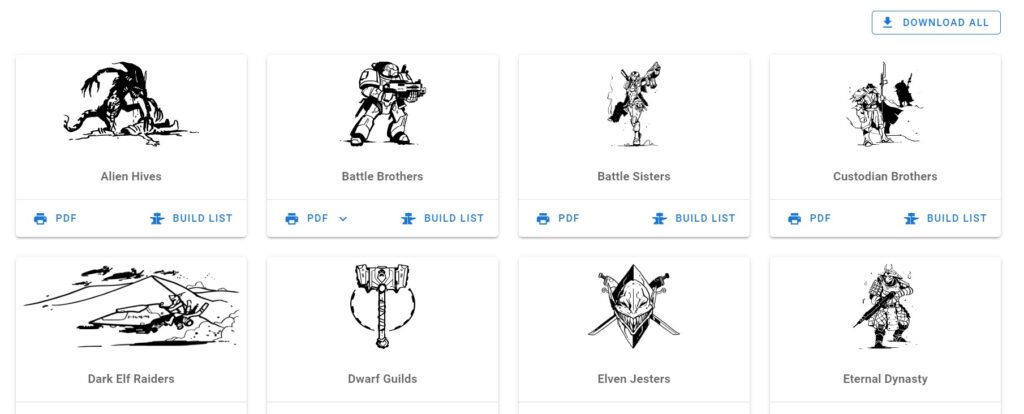
Lots of Armies
So, not to worry: GDF has a version of your favorite 40K faction, even the less popular ones such as “Custodian Brothers” (Adeptus Custodes). In case you’re wondering, GDF has a “Dwarf Guilds” army that, as of this writing, appears to be more like the Rogue Trader-era Squats than the recently-released Leagues of Votann, but that may very well change soon.
GDF also has armies not in 40K. Among them are:
- Eternal Dynasty: A Japanese-style army of infantry, cyborg animals, and high-tech robots;
- Jackals: Just what it sounds like—canine humanoids with guns;
- Ratmen Clans: In case you want to use your Skaven army; and,
- Saurian Starhost: Lizardmen in space!
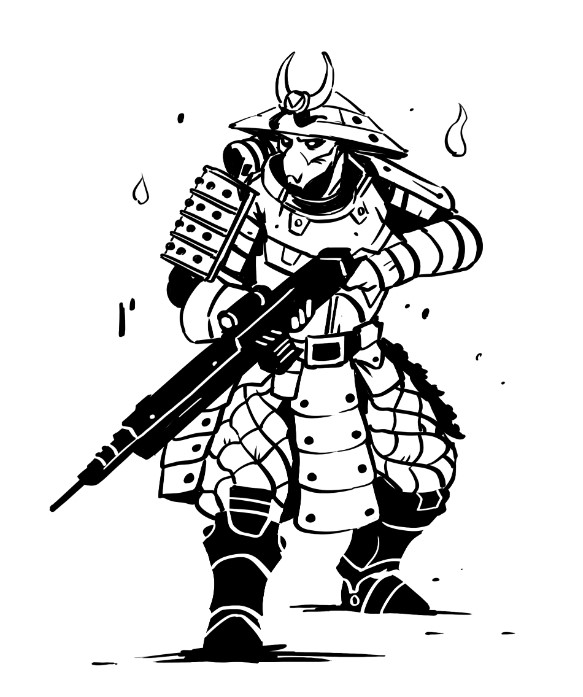
Shorter “Books”
Though OPR calls its collection of lists “Army Books,” each is little more than a few sheets, vastly shorter than the current 120+ page hardcover codices that GW publishes for each faction. The background, or “fluff,” for each GDF army is limited to a few paragraphs, and the sum total of the artwork is a single black and white representative drawing on the front page of each “book.”
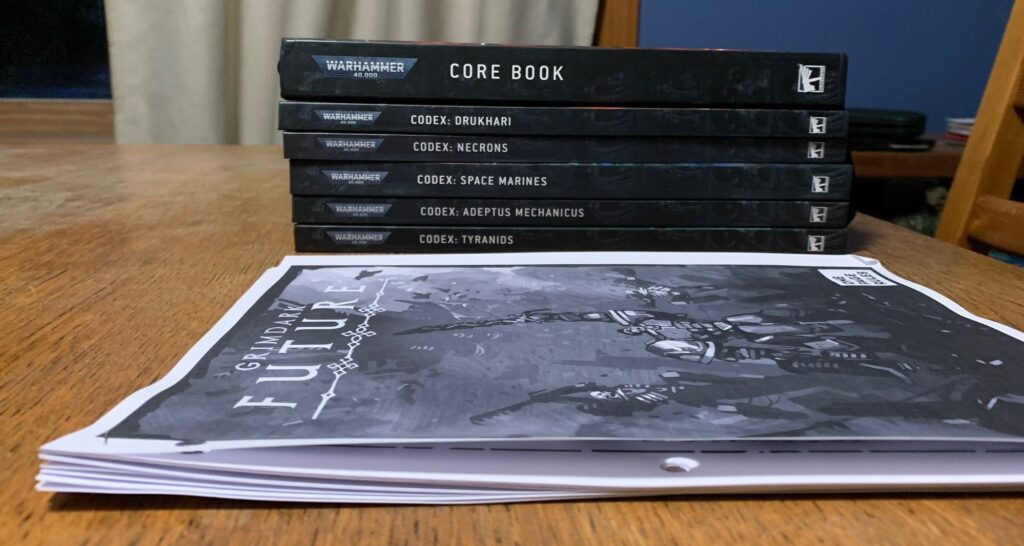
If you’re looking for substantive fiction, detailed descriptions, evocative photographs, or lavish illustrations, you are sorely out of luck with the GDF “army books.” The writers assume that you are already familiar with the 40K faction (or army from another game) that each “book” is trying to emulate, so the emphasis is on providing rules for using models in GDF games.
No Force Organization Charts
Shortly after First Edition (or “Rogue Trader”) began, Warhammer 40K armies were required, at a minimum, to have certain units: a commanding officer, for example, and a certain number of squads. This continued through Second Edition (where a force had to have at least 25% of its total points values spent on Infantry).
Third Edition codified this with Force Organization Charts, where just about every game called for at least one HQ unit and two Troop units. This requirement has continued, with some permutations, to the present day.
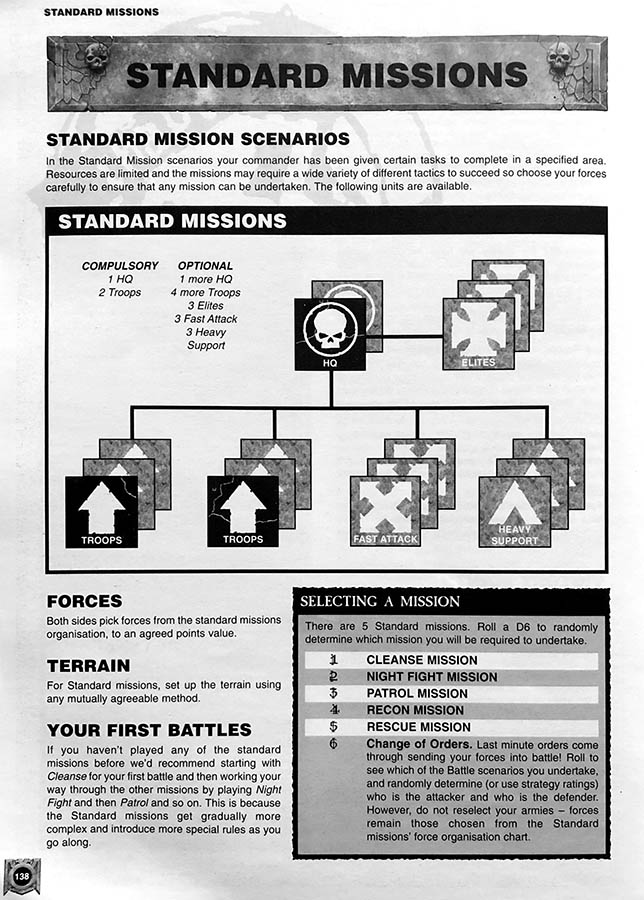
It might come as a shock to you, then, to learn that GDF has no FOCs, or anything like that. You don’t need to field what 40K calls an HQ unit, or any Troops.
You can also field however many of a certain unit you like, even if they’re what 40K would consider Elite, Fast Attack, Heavy Support, Flyer, or Lord of War. If you want to field an army of nothing but Space Marine Dreadnoughts—I’m sorry, “Battle Brother Attack Walkers”—there’s nothing stopping you.
As a matter of fact, there’s no reason why you can’t make up your own unique force by selecting units from various factions and having them fight as one, in the same vein as 40K Open Play. I don’t know why an Alien Hive Snatcher Lord (Tyranid Broodlord) would team up with Havoc Brother Lust Cultists (Chaos Noise Marines) and two units of TAO Coalition Grunt Squads (T’au Fire Warriors) riding an Orc Marauder Battle Rig (Ork Battlewagon), but if that floats your fishing vessel, go for it.
Fewer Units, Fewer Wargear
The Adeptus Astartes have over 100 unit choices in the 9e codex. There’s no way that a company calling itself “OnePageRules” would try to duplicate that, nor would they want to.
While you’ll find all the basic units readily represented—the Battle Brothers have analogs of Tactical Marines, Assault Marines, and Devastator Marines—some of the more obscure ones have been rolled up into generic types that can be customized to better reflect what you’re trying to field. The conversion process isn’t always perfect, and sometimes, features get lost.
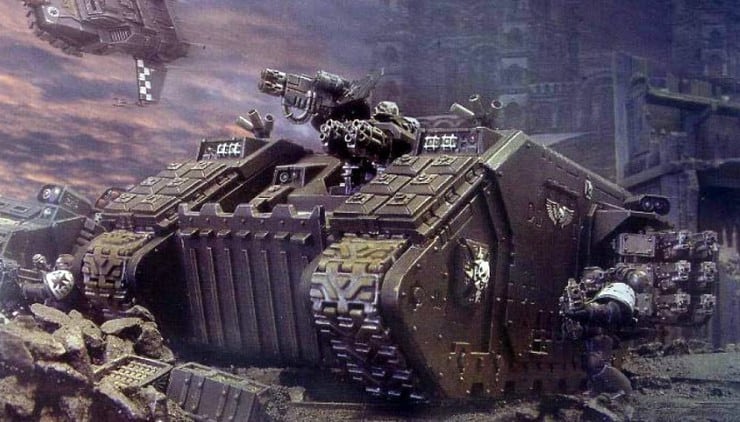
For example, a Land Raider Crusader becomes, in GDF, a “Heavy Tank” fitted with “twin heavy rifle arrays.” But instead of having a capacity of 16, as you’re used to for the LRC, it has a capacity of 11, and there’s no way to increase that (unless you design your own version. More about that later).
Almost all army units in GDF have options for “upgrades” of different weapons, wargear, and/or abilities (including psychic powers). The choices of upgrades are significantly fewer than what you’ll find for just about any unit in any codex.
Fewer Special Rules
And really, thank God for fewer special rules. As I mentioned in my first post, it wasn’t so much the core 9e 40K rules that caused my issues with the game, it was the insane amount of needlessly-complicated, mentally-taxing rules, a few army-wide, most for specific units, found in each codex. All of which you’re supposed to remember and keep straight, and know when to use under what circumstances, all in the heat of playing.
I mean, look at this monstrosity from Codex: Necrons:
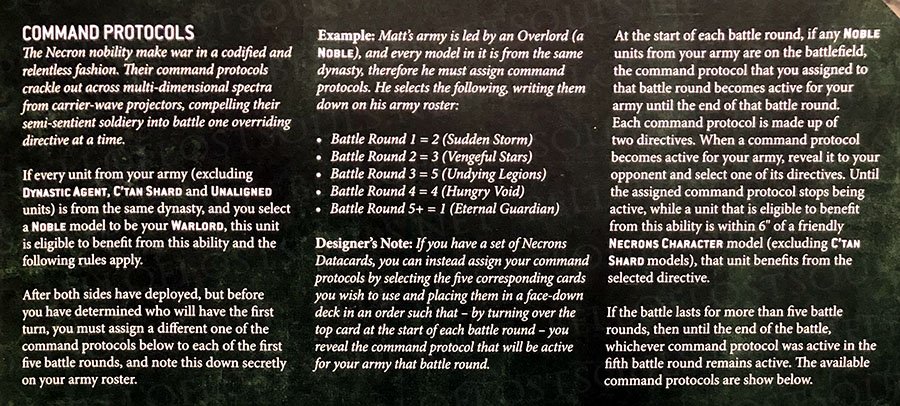
Yes, it’s very much in character for a force of mindless robots. But bear in mind that each Command Protocol (of which you take five in each game) has two Directives, so that’s 10 more things, on top of all the other stuff, that a Necron player must consider during a game.
And why is this even necessary? This rule is new for 9th Edition: ‘Bot players had been getting along very well without it since Necrons fully arrived in 2002, during 3rd Edition.
GDF says, “To hell with that.” Armies use some rules found in the basic book (the kind that 40K used to call the “Universal Special Rules”), and have a handful of their own, specific rules.
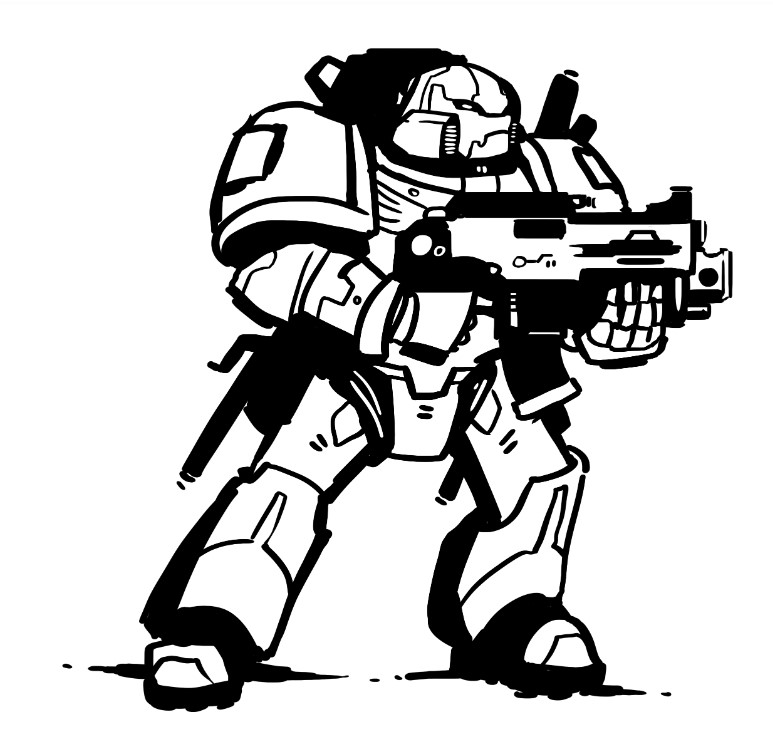
Yes, some armies do lose a bit of flavor. Battle Brothers, for example, are not nearly as blessed as Space Marines are. A typical BB only has the Fearless special rule, meaning that he gets +1 on his Morale checks. His 40K cousins, on the other hand, enjoy And They Shall Know No Fear; Bolter Discipline; Combat Doctrines; and Shock Assault.
No Stratagems
Again, thank God for that. Neither the basic GDF rules (available for free) nor the army write-ups have Stratagems. Like many of 9e’s rules, they seem cool and useful and very in character when considered separately. But there’s the rub: each Stratagem, of which each 40K army has many, is just one more rule to remember and use appropriately, along with all the other rules and Stratagems, in the midst of a game.
The GDF Full Rulebook, which is available for purchase, has rules for Command Points, and perhaps those are used for the game’s version of Stratagems, if there are such things. I don’t have the Full Rulebook, so I can’t confirm that. Frankly, I don’t intend to go looking down that rabbit hole.
Fixed (and Sometimes Smaller) Unit Sizes
Ninth Edition 40K codices usually allow one to field a number of models within a unit: 1-2 or 1-3 for some, like vehicles or monsters; 5-10 or 5-20 for infantry; 10-30 for hordes of vicious scrubs like Termagants, and so on.
GDF is much more prescribed: you get 1 of something; or 3 of something else; or 5 of this (usually troop types); or 10 of that. If you’d like to have a larger unit of something, you can take two squads and combine them into one.
For example, basic Battle Brother squads (Space Marines) come with 5 men; if you’d like to have a 10-man unit, you merge two 5-man squads that are thereafter treated as one (and no, you can’t split combined squads, even Battle Brothers, during the game).
Even by combining units in GDF, you still sometimes wind up with smaller squads than you would when playing 40K. Tyranid Termagants can be had in broods as large as 30; combining two units of the corresponding Alien Hive Shooter Grunts would only get you 20.
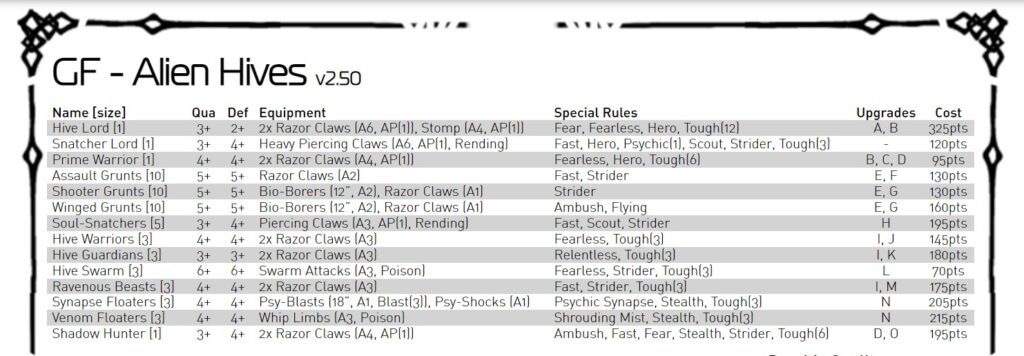
What if you have an existing unit that numbers something other than 5 or 10? The rules don’t say, but instead of disallowing the squad, or cutting its numbers, I would adjudicate it by adjusting the points cost, as in the case below.
My 40K Necron army had a squad of 9 Immortals, legal under the 9e codex, which allows one to have units of 5-10. GDF Robot Legions, however, set the size of a squad of Eternals (the GDF equivalent) to a strict five. When I converted the squad to my Robot Legions army, I counted it as one unit of five Eternals, combined with one unit of four.
To determine the points cost for the smaller squad, I took the base of 195 points for five Eternals; divided it by 5 to came up with 39 points each; then multiplied 39 x 4 to get a total of 156. I then added 156 to 195 to get a total of 351 for the unit (and yeah, GDF units are expensive. More about that in a bit).
I don’t know if that’s technically legal under the rules, but I know I wouldn’t mind if someone I was playing against did that. However, seeing as how Morale checks depend on squad size, I would not be cool with someone combining more than two units to make huge super-mobs of 100 Shooter Grunts, or Goblins, or Orcs.
Higher Point Costs
I mentioned that GDF Robot Legion Eternals cost 39 points each, or 195 for 5. That’s much higher than the 17 points MSRP for Immortals in the 9e Codex: Necrons. In fact, you’ll find that almost everything in GDF costs more points than it does in 40k (and no, GDF doesn’t have anything like 40K Power Ratings, so you must use Point Values, even though using Power Ratings is clearly easier and better).
Here’s a list of some 40K models and their Point Values, without any upgrades, compared with their GDF equivalents.
| 40K | PV | GDF | PV |
| Hormagaunt | 8 | Assault Grunt | 13 |
| Termagant | 7 | Shooter Grunt | 13 |
| Hive Tyrant | 160 | Hive Lord | 325 |
| Genestealer | 16 | Soul Snatcher | 39 |
| Carnifex | 100 | Carnivo-Rex | 275 |
| Tactical Marine | 18 | Battle Brother | 29 |
| Terminator | 38 | Destroyer | 85 |
| Space Marine Bike | 30 | Brother Biker | 90 |
| Land Raider | 285 | Heavy Tank | 630 |
| Predator Destructor | 140 | Battle Tank | 480 |
| Necron Warrior | 13 | RL Warrior | 25 |
| Necron Doom Scythe | 200 | Doom Fighter | 360 |
| Drukhari Kabalite Warrior | 8 | Dark Elf Warrior | 23 |
| Archon | 65 | Dark Lord | 55 |
| Reaver | 10 | Jetbike Rider | 80 |
| Talos | 110 | Engine of Suffering | 205 |
In my first game with them, my GDF Robot Legions army totaled 1986 points; the 40K version would have been 926. The “sticker shock” of paying much higher points than what I’d been used to was jarring at first, but I soon got over it. I used to write up 2000-point army lists for 40K games; I think I’ll be writing up 3000-point army lists when playing GDF.
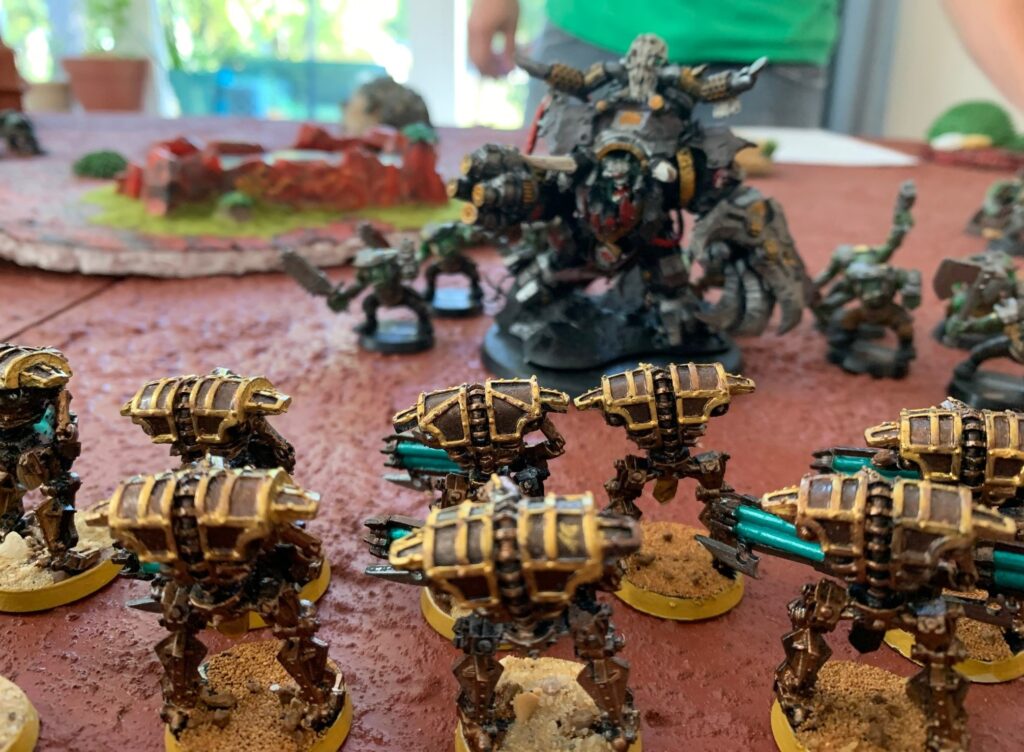
Why do GDF point values almost always run higher than 40K? I can only surmise that it’s because GDF uses some sort of prescribed formula for determining unit costs, whereas, I’ve read, that costs for 40K units are determined in relation to each other. I don’t know for certain if that’s true for either game system: I’m just guessing. But more about that GDF formula below.
Underpowered Units
A comparison of some GDF units to their 40K counterparts could easily give you the impression that the former are underpowered. For example:
- GDF Battle Brothers do not have 2 Wounds each, like 40K Space Marines do;
- Battle Brother Destroyers each have 1 Wound and save on a 3+, as opposed to SM Terminators with 3 Wounds each and a 2+ save;
- Robot Legion Doom Fighters have 6 Wounds, while Necron Doom Scythes have 12;
- Dark Elf Jetbike Riders have a base movement of 10″, while Drukhari Reavers have 18″;
- Your troop-level Orc Marauders have 3 attacks on the charge, not 4, like typical Ork Boyz;
- In GDF, there are no Rapid Fire weapons that double their shots at half range;
- A GDF “heavy fusion rifle” has a single shot at 18″ and does a flat 6 points of damage; a 40K multi-melta has two shots at 24″, each doing d6+2 within 12″
And so on. While GDF units and wargear often don’t seem as powerful as their 40K inspirations, they do appear to be well-balanced against each other. Admittedly, that’s just my initial impression: I haven’t yet dived into each army list and crunched numbers.
But given GDF’s simplicity and the lesser power of each army, unit, and wargear relative to what they are in 40K, that could very well be true. If it is, then that’s another feather—a very big, colorful feather—in GDF’s cap. Game balance has almost always been an issue in 40K: after all, it gave us the term “codex creep.”
So, no, GDF Battle Brothers are not the badasses that 40K Space Marines are. To my Ork-playing brother-in-law Drew, who hates Space Marines more than he hates the Dallas Cowboys and the Pittsburgh Penguins, this is a good thing.
If you’ve been with 40K for a very long time, like I have, the “underpowered” GDF units may remind you of how certain 40K units used to be in long-ago editions. Remember back in the Rogue Trader days, when Space Marines were Toughness 3? Remember how in 2nd Edition, Orks were not the melee monsters they are today? Yeah, exactly.
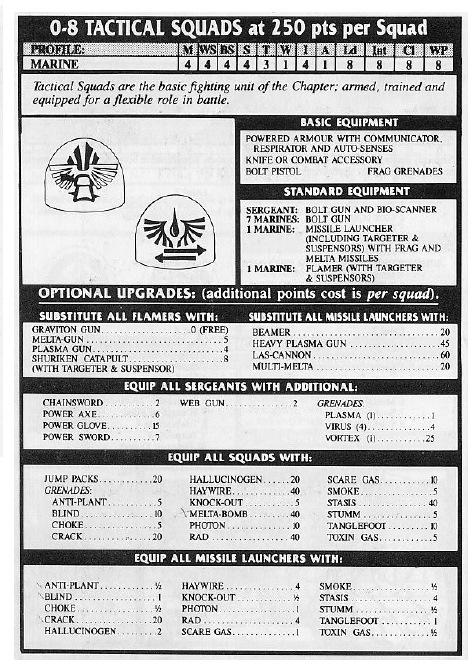
No Special Characters
Because 40K characters like Abaddon, Roboute Guilliman, Maugan Ra, and Ghazghkull Thraka are GW’s intellectual property, GDF does not provide counterparts for them in the army books. If you previously included these characters in your 40K forces, you can downgrade them to their generic equivalents (e.g. counting Ghaz as a Big Boss), or you can create GDF versions using the online Points Calculator.
Say what?
Making Your Own Units: the OPR Points Calculator
Though you can play GDF perfectly well with the resources you find for free on their site, OPR does offer expanded rules and additional benefits to people who subscribe to their Patreon. One of those benefits is the Points Calculator feature on their site that allows one to create custom units to use in GDF games.
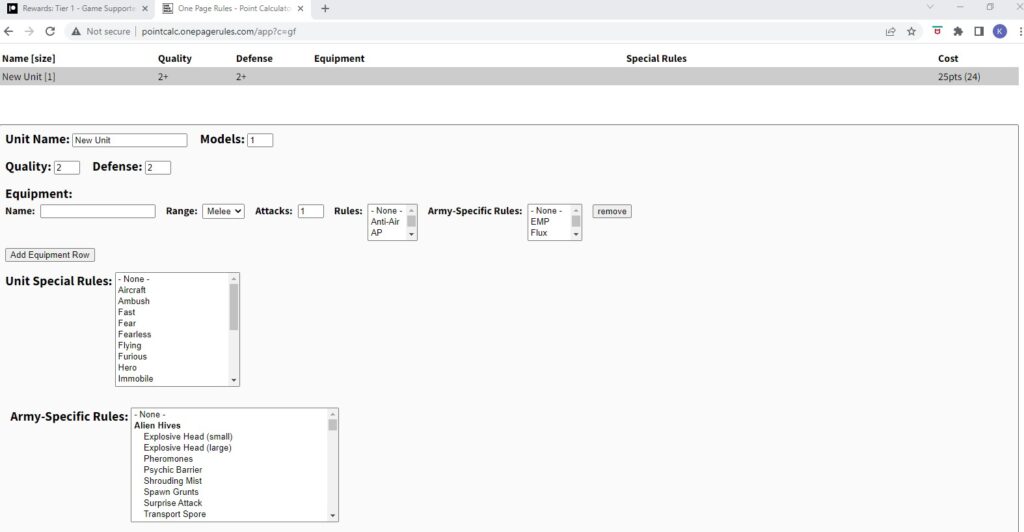
How it works is that you enter the attributes you want for your proposed unit, and add equipment and special rules from drop-down menus. The app calculates the cost for you, which will become increasingly steep with the more awesomeness you ladle onto your creation.
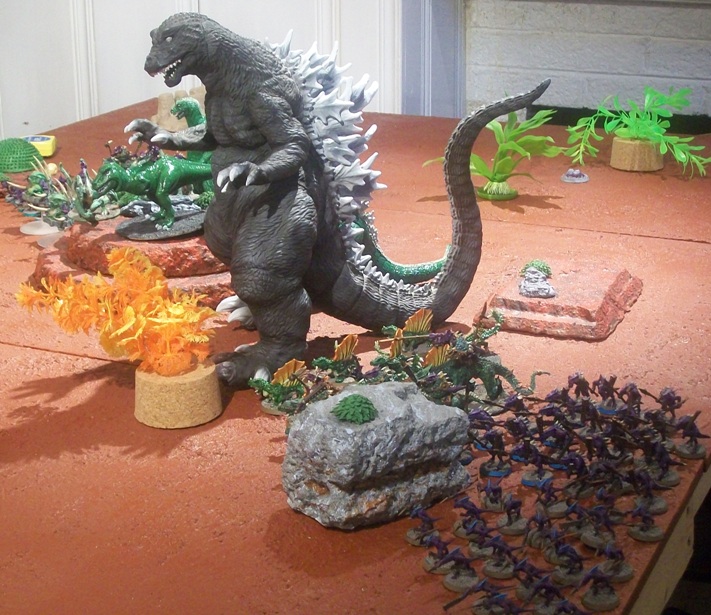
I’m in the process of drafting up the GDF version of “Big G,” the 12″ Godzilla model I use with my Kurindans (Space Lizardmen). So far, he’s about 7500 points, or the equal of two entire armies. I’ll keep tweaking him to find a happy medium between badassery and exorbitant costs.
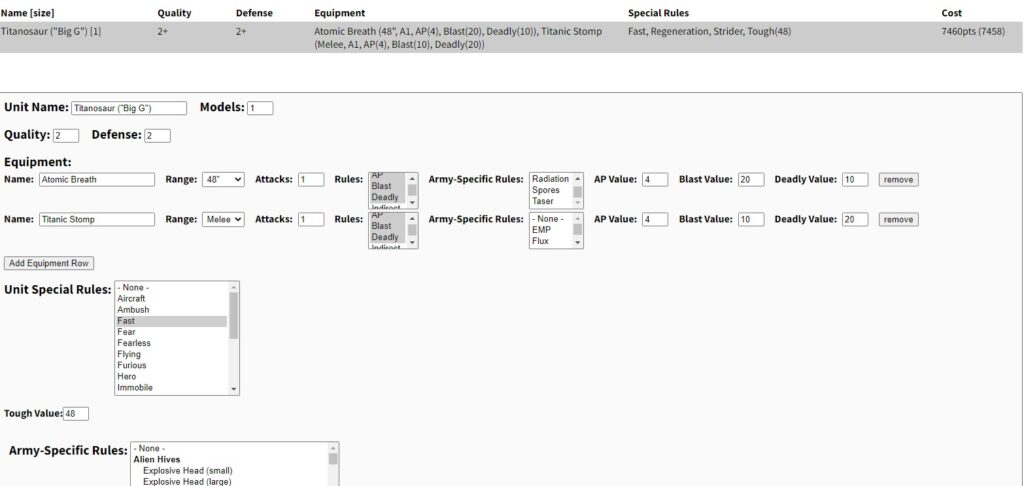
Conclusion
If you’re a casual gamer, you’ll probably be satisfied with how armies in GDF work. You may find yourself wishing that there were some more unit- or equipment options, or you might want certain units to perform more like their 40K counterparts. But if you’ve taken up GDF because you think 9e 40K is too complicated, I believe you’ll find the tradeoff of simplicity vs. features worth it.
If you’re more of a competitive gamer, however, you may be frustrated by GDF’s stripped-down rules and lack of options, particularly Stratagems. In which case, maybe you sign up on Patreon and get the GDF Full Rulebook, or buy it on DriveThru RPG for $4.99. I haven’t read it yet, so I can’t tell you if it would be more to your liking.
To date, I’ve only played one GDF game, but I’ve already noticed that it’s a bit more nuanced than I previously thought. So, there might be enough tactical challenges built into the game to keep your interest, if what you enjoy about 40K is the competition.
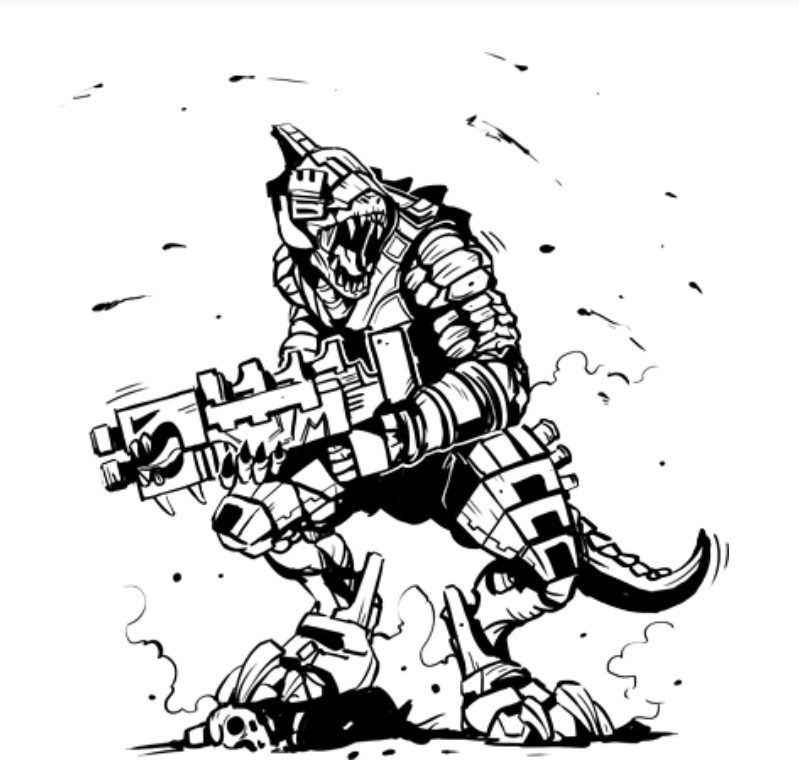
And if you want to play armies that 40K doesn’t offer, I think you’ll like taking some of GDF’s armies for a spin. I’ve always used the Tyranid rules for my Kurindans, but I’m itching to see how they’d turn out as a Saurian Starhost. I’ll be converting my six 40K armies over to their GDF equivalents, and I’ll let you know how that goes.
Kenton Kilgore writes killer SF/F for young adults and adults who are still young. The Fighting Tigers of Veda appear in his latest novel, Stray Cats, which you can find here.

Check him out on kentonkilgore.com, and follow Kenton on Facebook for frequent posts on sci-fi, fantasy, and other speculative fiction. You can also catch him on Instagram, and find his books in softcover and for Kindle on Amazon.
